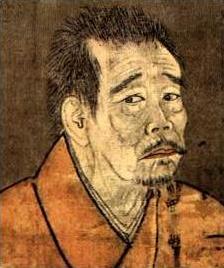This article contains information about the literary events and publications of 14th century.
This article contains information about the literary events and publications of the 13th century.
The Shin Kokin Wakashū, also known in abbreviated form as the Shin Kokinshū (新古今集) or even conversationally as the Shin Kokin, is the eighth imperial anthology of waka poetry compiled by the Japanese court, beginning with the Kokin Wakashū circa 905 and ending with the Shinshokukokin Wakashū circa 1439. The name can be literally translated as "New Collection of Ancient and Modern Poems" and bears an intentional resemblance to that of the first anthology. Together with the Man'yōshū and the Kokinshū, the Shin Kokinshū is widely considered to be one of the three most influential poetic anthologies in Japanese literary history. It was commissioned in 1201 by the retired emperor Go-Toba, who established a new Bureau of Poetry at his Nijō palace with eleven Fellows, headed by Fujiwara no Yoshitsune, for the purpose of conducting poetry contests and compiling the anthology. Despite its emphasis on contemporary poets, the Shin Kokinshū covered a broader range of poetic ages than the Kokinshū, including ancient poems that the editors of the first anthology had deliberately excluded. It was officially presented in 1205, on the 300th anniversary of the completion of the Kokinshū.

Ikkyū was an eccentric, iconoclastic Japanese Zen Buddhist monk and poet. He had a great impact on the infusion of Japanese art and literature with Zen attitudes and ideals, as well as on Zen itself, including breaking Buddhist monastic teachings with his stance against celibacy.
Shōtetsu was a Japanese poet during the Muromachi period, and is considered to have been the last poet in the courtly waka tradition; a number of his disciples were important in the development of the renga art form, which led to the haiku.
This page is part of the List of years in poetry. The List of years in poetry and List of years in literature provide snapshots of developments in poetry and literature worldwide in a given year, decade or century, and allow easy access to a wide range of Wikipedia articles about movements, writers, works and developments in any timeframe. Please help to build these lists by adding and updating entries as you use them. You can access pages for individual years within the century through the navigational template at the bottom of this page, and you can access pages for other centuries through the navigational template to the right. To access the poetry pages by way of a single chart, please see the Centuries in poetry page or the List of years in poetry page.
The Gozan Bungaku or literature of the Five Mountains is the literature produced by the principal Zen (禅) monastic centers of in Kyoto and Kamakura, Japan. The term also refers to five Zen centers in China in Hangzhou and Ningbo that inspired zen in Japan, while the term "mountain" refers to Buddhist monastery.
Nationality words link to articles with information on the nation's poetry or literature.
Nationality words link to articles with information on the nation's poetry or literature.
Nationality words link to articles with information on the nation's poetry or literature.
Nationality words link to articles with information on the nation's poetry or literature.
Nationality words link to articles with information on the nation's poetry or literature.
Nationality words link to articles with information on the nation's poetry or literature.

Waka is a type of poetry in classical Japanese literature. Although waka in modern Japanese is written as 和歌, in the past it was also written as 倭歌, and a variant name is yamato-uta (大和歌).

